Give Every Child a Voice:
Using a Universal Approach to AAC in the Early Years
In this edition of the LINC Blog, AAC Coach and SEN Teacher Melanie Boyle shares her insights on using a universal approach to AAC in early years settings. Drawing on her dual perspective as both a professional and a parent of an AAC user, Melanie explores how we can embed inclusive communication strategies that benefit all children. She introduces practical tools like Project Core and communication boards, showing how simple, everyday practices can empower young learners to express themselves and be truly heard. Whether you’re an educator, practitioner, or parent, this blog offers valuable guidance on giving every child a voice.
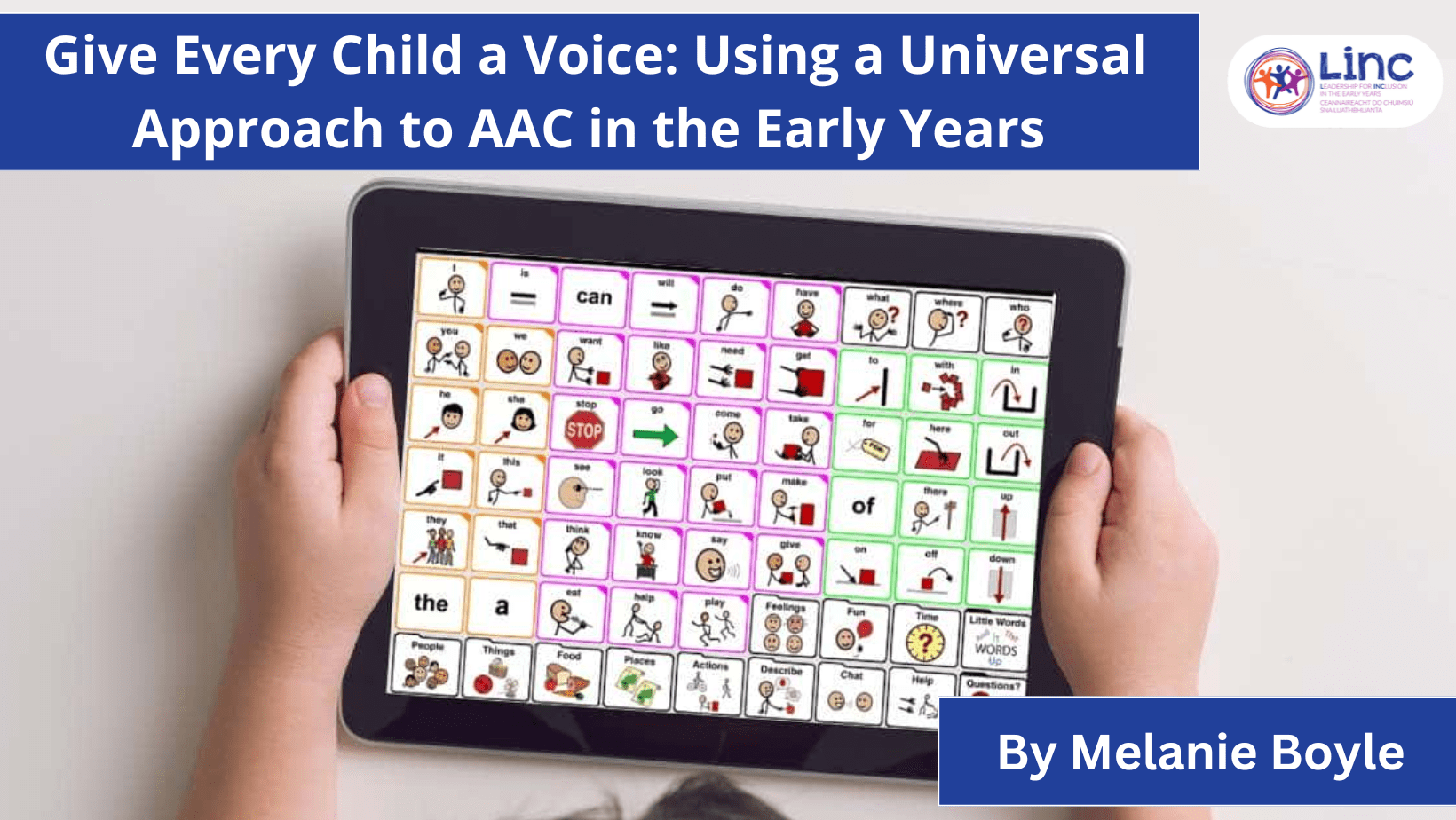
Communication is a fundamental human right. Every child deserves a way to express themselves, be heard, and participate in the world around them. Yet, for many young children with complex communication needs, verbal speech may not develop in the same way or at the same time as their peers. This is where Augmentative and Alternative Communication (AAC) plays a crucial role. By embedding a universal approach to AAC in early years settings, we can create a language-rich environment that benefits all children, not just those with identified communication challenges.
AAC stands for Augmentative and Alternative Communication, and it includes a wide range of tools that can support children with speech difficulties. Augmentative communication refers to supplementing speech through gestures, sign language, facial expressions, and body language. Alternative communication replaces speech altogether, such as using symbols, written language, or speech-generating devices.
AAC is particularly important for children who have unreliable speech or who cannot meet their needs through spoken language alone. These children can benefit from AAC systems that allow them to communicate effectively, whether through communication boards, devices, or other forms of assistive technology.
Aistear 2024 and the Role of Universal AAC
Aistear, the early childhood curriculum framework in Ireland, emphasises the importance of communication and language development as key pillars of learning. The 2024 update reinforces the need for inclusive practices that support all children, including those who use AAC.
Universal AAC benefits everyone and doesn’t need to break the bank or your training and resources budget!
As the procurement of AAC devices involves a lengthy assessment process one of the most effective ways to ensure every child has access to AAC is through a universal approach—introducing core vocabulary and multimodal communication strategies across all learning activities. This can be achieved through the use of communication boards.
Project Core: A Simple and Powerful AAC Framework
Project Core is a FREE resource developed by the Centre of Literacy and Disability Studies . It provides an evidence-based, easy-to-implement approach to teaching core vocabulary through symbolised communication boards (Benson-Goldberg, S et al 2023 & Geist,L et al 2021). Core vocabulary are the words we use most frequently to express ideas and interact with others. Instead of focusing on topic-specific words (fringe vocabulary), Project Core centres on high-frequency words like “go,” “stop,” “more,” “help,” and “want.” These words are incredibly versatile and can be used across different activities and settings.
Project Core offer 8 FREE professional development modules and downloadable communication boards in multiple formats. Everything is there and ready for you to get started in your early years setting. By using these communication boards during everyday activities, we create multiple opportunities for children to see and use AAC in meaningful ways.
The Importance of Communication Boards
Using communication boards in early years settings has numerous benefits:
- Supports all learners: Communication boards can be used by all children, not just those with communication difficulties. They foster a shared language and promote inclusivity.
- Reduces frustration: With communication boards, children have an alternative means to express themselves, which can lead to fewer behavioral issues.
- Supports language development: Communication boards offer opportunities to practice language skills, both in terms of receptive and expressive communication.
- Builds confidence: When educators and practitioners consistently use communication boards, children gain confidence in their ability to communicate effectively.
Model AAC During Play
Aistear described the slow relational pedagogy as slowing down, taking time, being present in that moment with the baby, toddler and young child. This links well with the communication skills you need to create meaningful interactions which are engaging and motivating. It’s in these moments we build a connection by responding to their current communication style. We comment and invite responses through open ended questions. We tune in and reflect on what you see and understand from the baby, toddler and young child. We affirming efforts and attributing meaning to their communication in whatever way they have chosen.
During our recent webinar, participants contributed to the creation of these two Modeling Cheat Sheets:
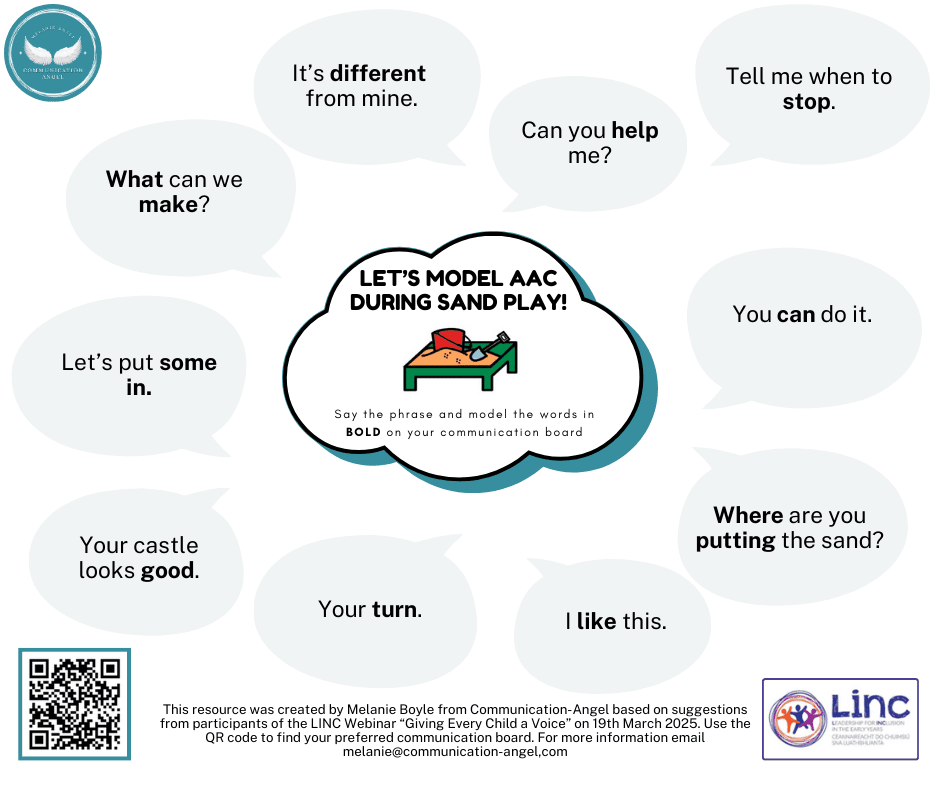
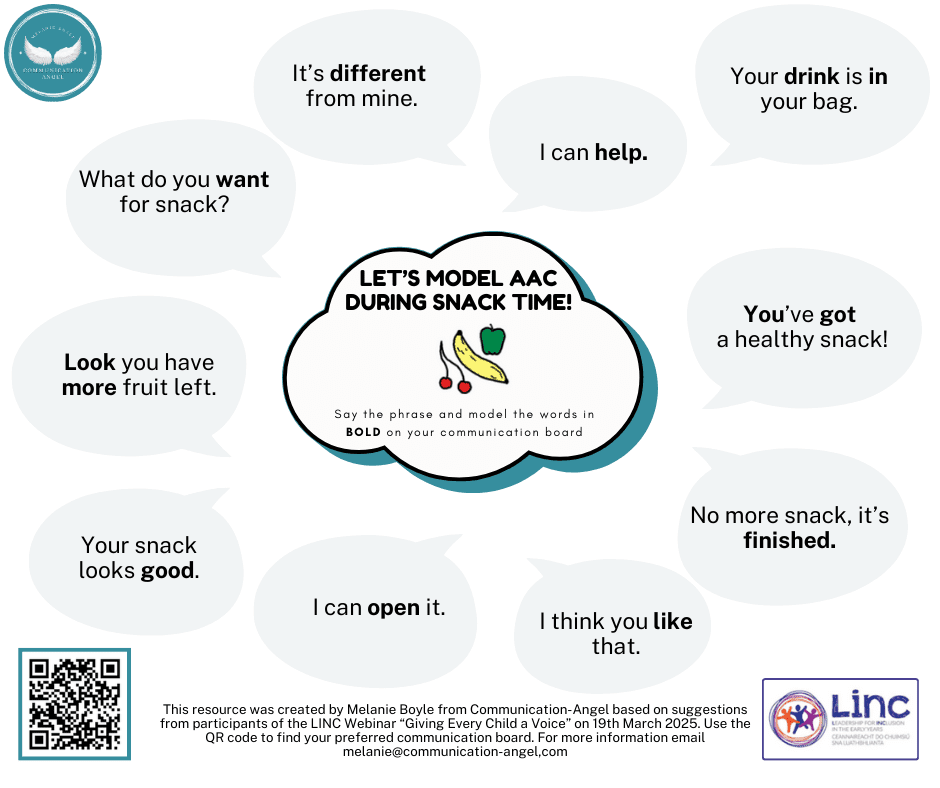
When modeling the use of core words, we don’t have to point to every word we say. We point to the key word in the sentence or phrase. See these examples:
“I think you like that.”
“Your snack looks good.”
“It’s different from mine.”
In each example phrase we only point to the symbol of the word in bold. In time when the child is ready you can begin to model or point to multiple symbols.
Practical Tips for Practitioners
As early years practitioners, your role in supporting communication is crucial. The strategies you use, the tools you introduce, and the environment you create can all have a lasting impact on a child’s ability to express themselves.
- Be present: Slow down and be with the child in the moment. Observe what motivates them and respond to their communication cues.
- Model AAC: Whether you’re using a communication board or a device, model how to use AAC in natural contexts. This helps children learn how to communicate in the world around them.
- Create accessible environments: Have Project Core boards available in all key play and learning areas.
- Encourage all children to use AAC: When AAC is part of the environment, children naturally become familiar with it and may begin to use it themselves.
- Empower parents and caregivers: Share simple strategies so they can continue supporting AAC at home.
- Celebrate communication: Every effort, whether verbal or nonverbal, should be recognized and celebrated. By affirming their attempts, you reinforce the value of communication
Conclusion: Every Child Deserves a Voice
By embracing a universal approach to AAC in early years settings, we ensure that every child has access to a means of communication. Project Core provides a simple yet powerful way to support children in expressing themselves, engaging with peers, and developing language skills in meaningful contexts. When we integrate AAC into everyday activities—whether through water play, dressing up, snack time, or outdoor adventures—we give every child the opportunity to be heard.
Let’s commit to making communication accessible for all. When we model, support, and celebrate every child’s voice, we truly create an inclusive, language-rich learning environment. When we do this we’re not just teaching children how to communicate—we’re teaching them that their voice matters.
To explore additional downloadable resources follow this link
References:
Benson-Goldberg, S., Geist, L. and Erickson, K. (2023) ‘Expressive Communication Over Time: A Longitudinal Analysis of the Project Core Implementation Model’, Communication Disorders Quarterly, 45(1), pp. 64–72. Available at: https://doi.org/10.1177/15257401221120790 . [Accessed 31 Mar. 2025]
Geist, L., Erickson, K., Greer, C., & Hatch, P. (2021). Initial evaluation of the Project Core implementation model. Assistive Technology Outcomes and Benefits, 15, 29-47. https://www.atia.org/wp-content/uploads/2021/03/V15_Geist_etal.pdf [Accessed 31 Mar. 2025]
National Council for Curriculum and Assessment (NCCA), 2024. Aistear: The Early Childhood Curriculum Framework. Dublin: NCCA. Available at: https://curriculumonline.ie/getmedia/f2932ad8-326d-4cb7-9d6c-09bc138f9a8a/Aistear-G-ENG.pdf [Accessed 31 Mar. 2025]

Melanie Boyle
AAC Coach and SEN teacher
Melanie Boyle is an experienced AAC Coach and SEN teacher, whose professional journey has been shaped by both her expertise and lived experience as a parent of an AAC user. She believes that being non-speaking doesn’t mean having nothing to say. Passionate about fostering inclusive communication, Melanie supports practitioners and parents in creating language-rich environments where all children can connect, express themselves, and thrive through AAC.
You may also like:

LINC Shines a Light on Inclusion for the International Day of Persons with Disabilities 2025
LINC Shines a Light on Inclusion for the International Day of Persons with Disabilities 2025 The Leadership for INClusion in the Early Years (LINC) Programme marked the United Nations International Day of Persons with Disabilities (IDPD) this evening by illuminating...
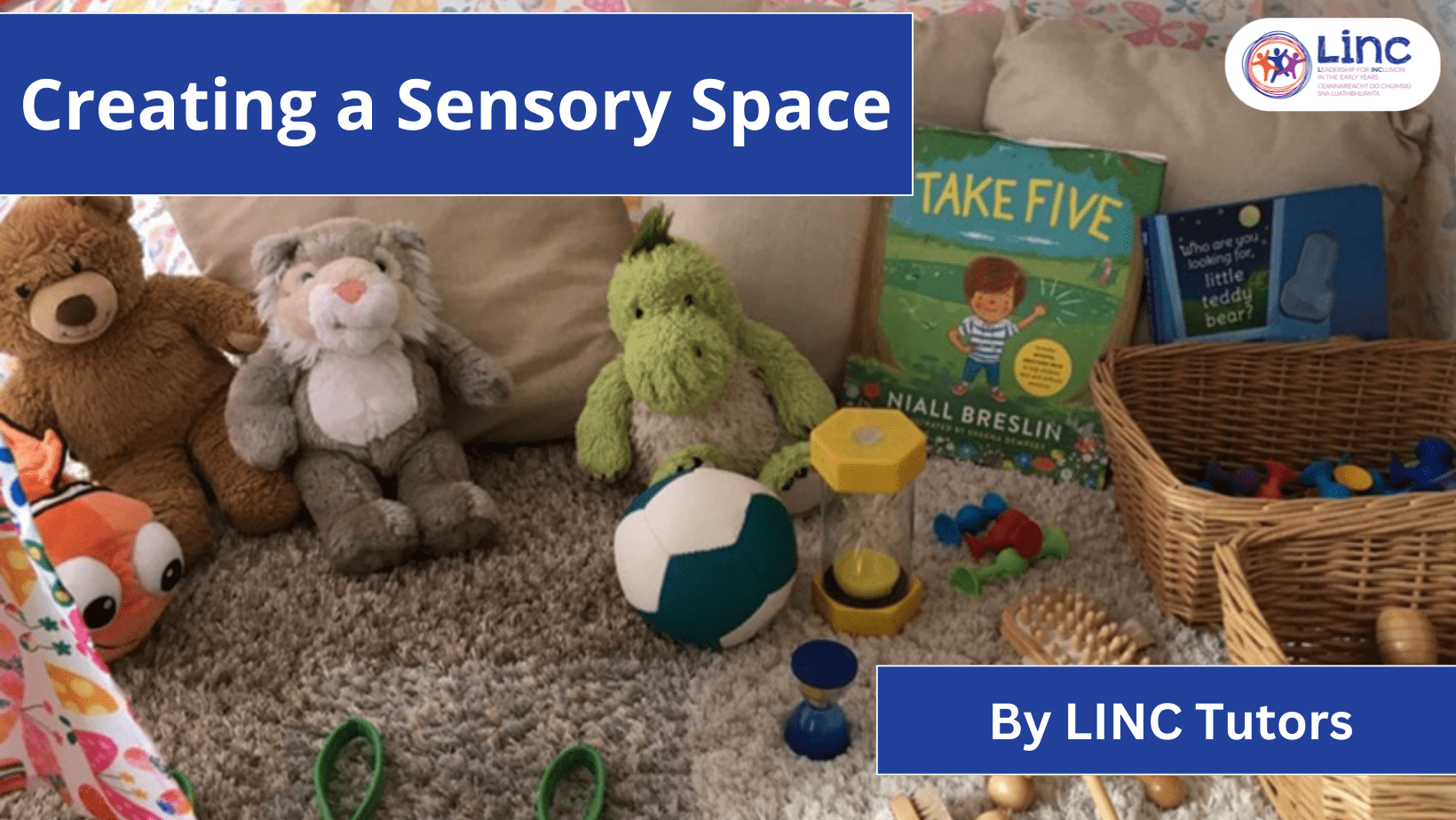
Creating a Sensory Space
Creating a Sensory Space In this edition of the LINC blog, Claire Butterly, Karina Abbott, Ann Donnellan, Carole Dee, Linda Madden, Margaret Joyce and Paula Harte highlight some considerations when planning a sensory space in your Early Learning and Care setting....
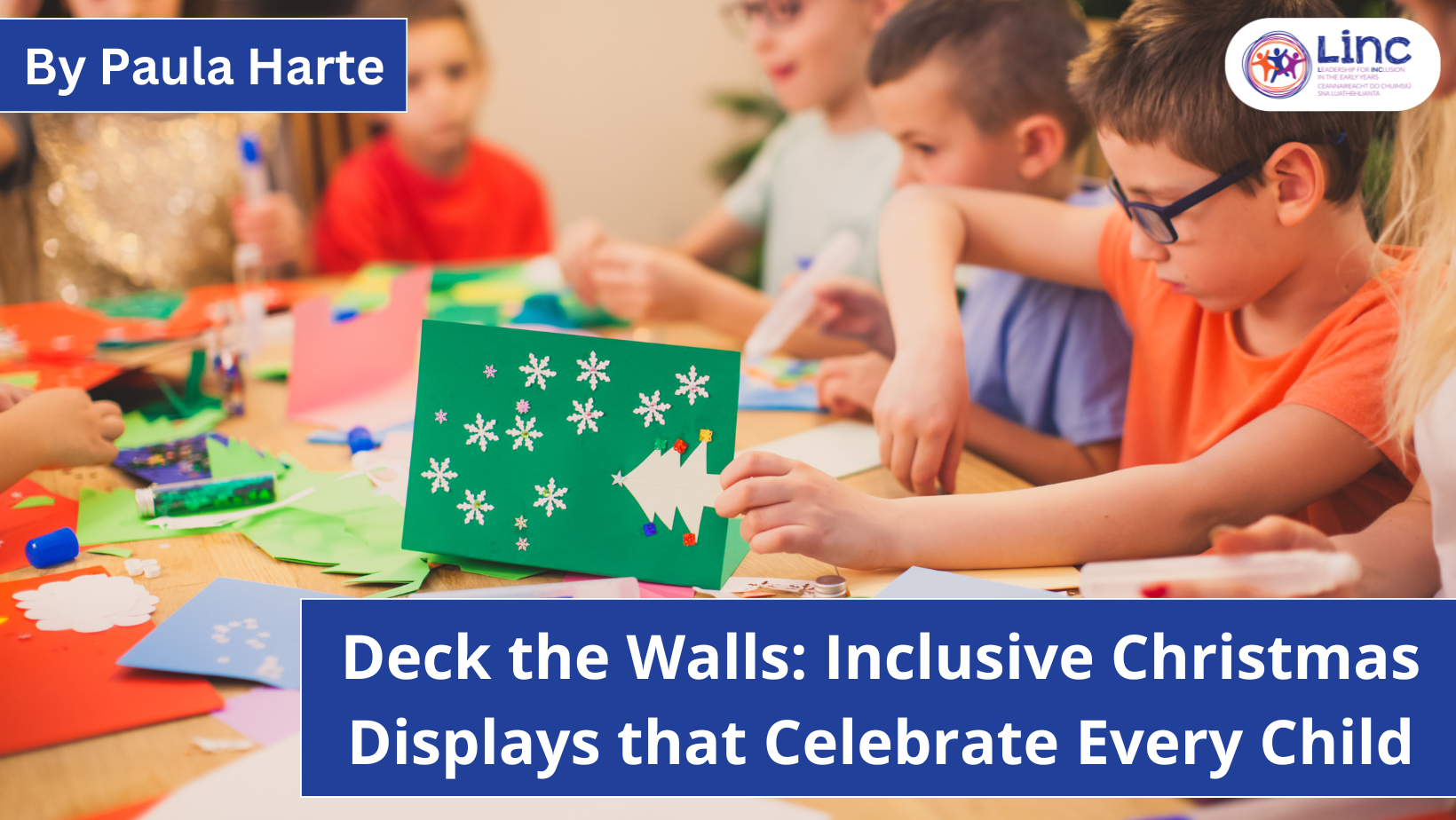
Deck the Walls: Inclusive Christmas Displays that Celebrate Every Child
Deck the Walls: Inclusive Christmas Displays that Celebrate Every Child In this edition of the LINC Blog, former LINC Tutor Paula Harte explores how Christmas displays can bring warmth, creativity, and connection to Early Learning and Care (ELC) and School-Aged...
